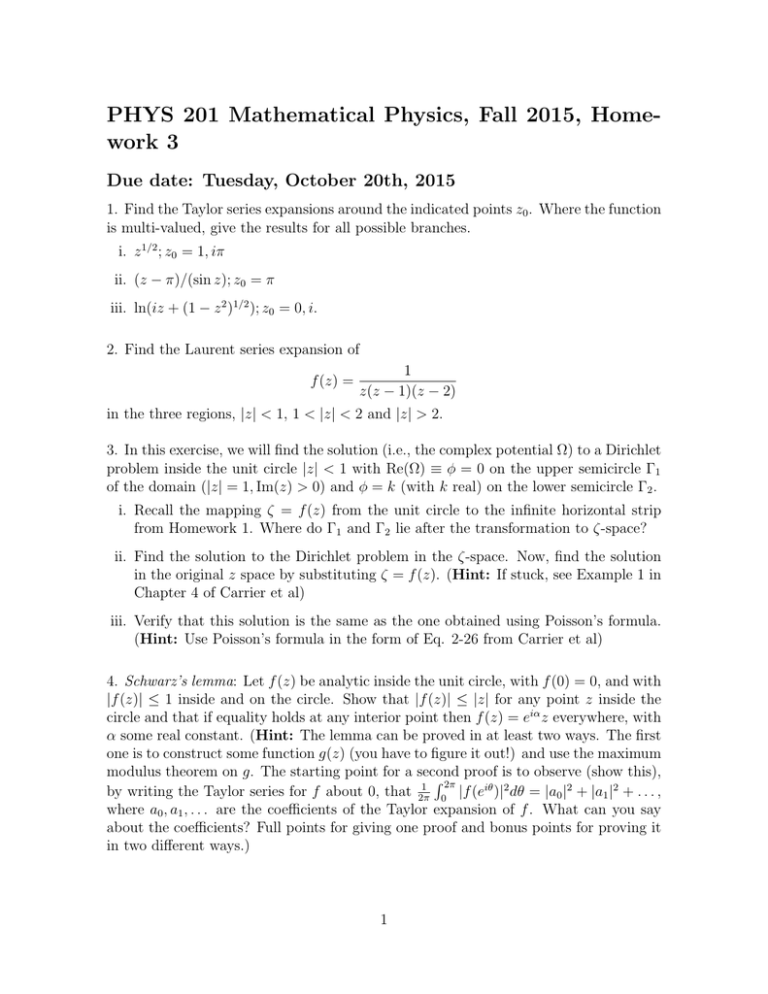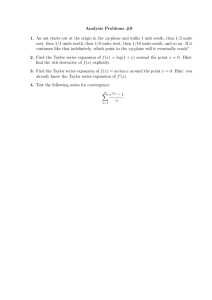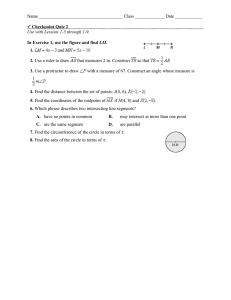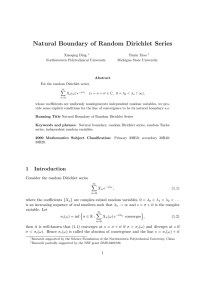PHYS 201 Mathematical Physics, Fall 2015, Home- work 3
advertisement

PHYS 201 Mathematical Physics, Fall 2015, Homework 3 Due date: Tuesday, October 20th, 2015 1. Find the Taylor series expansions around the indicated points z0 . Where the function is multi-valued, give the results for all possible branches. i. z 1/2 ; z0 = 1, iπ ii. (z − π)/(sin z); z0 = π iii. ln(iz + (1 − z 2 )1/2 ); z0 = 0, i. 2. Find the Laurent series expansion of f (z) = 1 z(z − 1)(z − 2) in the three regions, |z| < 1, 1 < |z| < 2 and |z| > 2. 3. In this exercise, we will find the solution (i.e., the complex potential Ω) to a Dirichlet problem inside the unit circle |z| < 1 with Re(Ω) ≡ φ = 0 on the upper semicircle Γ1 of the domain (|z| = 1, Im(z) > 0) and φ = k (with k real) on the lower semicircle Γ2 . i. Recall the mapping ζ = f (z) from the unit circle to the infinite horizontal strip from Homework 1. Where do Γ1 and Γ2 lie after the transformation to ζ-space? ii. Find the solution to the Dirichlet problem in the ζ-space. Now, find the solution in the original z space by substituting ζ = f (z). (Hint: If stuck, see Example 1 in Chapter 4 of Carrier et al) iii. Verify that this solution is the same as the one obtained using Poisson’s formula. (Hint: Use Poisson’s formula in the form of Eq. 2-26 from Carrier et al) 4. Schwarz’s lemma: Let f (z) be analytic inside the unit circle, with f (0) = 0, and with |f (z)| ≤ 1 inside and on the circle. Show that |f (z)| ≤ |z| for any point z inside the circle and that if equality holds at any interior point then f (z) = eiα z everywhere, with α some real constant. (Hint: The lemma can be proved in at least two ways. The first one is to construct some function g(z) (you have to figure it out!) and use the maximum modulus theorem on g. The starting point for a second is to observe (show this), R 2π proof 1 iθ 2 by writing the Taylor series for f about 0, that 2π 0 |f (e )| dθ = |a0 |2 + |a1 |2 + . . . , where a0 , a1 , . . . are the coefficients of the Taylor expansion of f . What can you say about the coefficients? Full points for giving one proof and bonus points for proving it in two different ways.) 1




